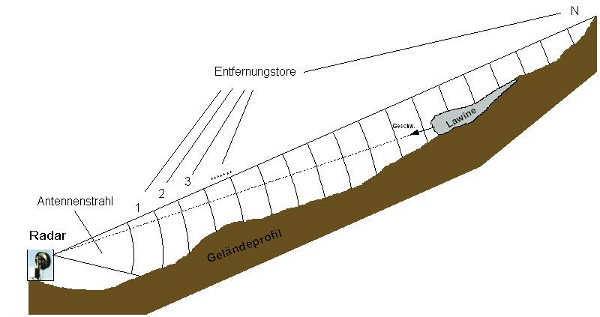
A Pulse - Doppler - Radar sends out a series of short microwave pulses which are scattered at the targets. A part of those scattered waves are reflected back to the radar receiver. For this application the optimum frequency lies in the C-Band (4 - 8 GHz) because at these frequencies signals are well-reflected by stationary or moving snow and are less influenced by atmospheric influences (weather).
The following types of measurement can be done by the radar system:
The range discrimination of the radar is regulated by so called range gates. This means that the received echo signal is sampled at given time-slots and each of these points in time corresponds to a range gate in distance. The avalanche uses normally a range gate length of 50 m. The principle of range gating is shown in the following figure.

The velocity is calculated from the radar data via the doppler effect. The frequency of the reflected signal (frefl) is shifted against the frequency of the transmitted pulse (f0) if the target is moving:
frefl = f0 + Δ f
This change in frequency of the echo signal is called doppler frequency shift. f0 is the frequency of the transmit pulse. For velocities which are small in comparison to the speed of light, the velocity can be calculated as follows:
Δ f = fDoppler =
| 2 vmeas f0 |
| c |
vmeas is the measured radial velocity (velocity component in the direction of the antenna beam) of the moving target.
This velocity component is positive if the moving target comes closer and negative if the objects gets away from the radar.
Any movement orthogonal to the antenna beam cannot be detected.
